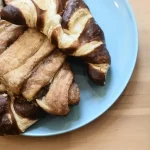The iced mocha latte, a ubiquitous fixture in modern coffee culture, boasts a surprisingly rich and complex history, far exceeding its seemingly simple composition. While pinpointing its exact origin is difficult, its lineage can be traced back to the individual components: the mocha, a chocolate-infused coffee drink whose origins are debated between Yemen and Italy, and the latte, a coffee drink with steamed milk, tracing its roots back to Italian coffee houses. The marriage of these two, resulting in the mocha latte, likely occurred in the latter half of the 20th century, with the iced version emerging as a refreshing alternative during warmer months. The exact year and place of the iced mocha latte’s birth remain shrouded in mystery, lost in the annals of coffee shop evolution.
The rise of the iced mocha latte mirrors the broader growth of the specialty coffee market. Between 2010 and 2020, the global specialty coffee market experienced substantial growth, with reports suggesting a compound annual growth rate exceeding 5%. This surge in popularity is closely linked to increased consumer demand for premium coffee beverages, including those offering unique flavor profiles and customizable options. The iced mocha latte, with its customizable sweetness and chocolatey indulgence, perfectly fits this profile. Furthermore, the trend towards healthier lifestyles has intersected with the iced mocha latte’s appeal, with many coffee shops offering options with plant-based milks, sugar-free syrups, and reduced-calorie options, catering to a wider range of consumer preferences.
Culturally, the iced mocha latte has become a symbol of modern café culture. It represents a blend of convenience, indulgence, and social interaction. It’s frequently featured in popular culture, often depicted as a quintessential accompaniment to social gatherings, work breaks, or leisurely afternoons. Its widespread availability, from independent coffee shops to large multinational chains, solidifies its place as a globally recognized beverage. The drink has transcended its initial niche appeal, becoming a staple in many countries, reflecting a globalized palate and a shared appreciation for sweet, refreshing coffee concoctions. The versatility of the iced mocha latte, adaptable to various tastes and preferences, contributes to its enduring popularity and cultural significance.
Understanding the historical context and cultural impact of the iced mocha latte provides a richer appreciation for its preparation and consumption. This introduction sets the stage for a detailed exploration of the techniques involved in crafting this beloved beverage, ensuring that the final product is not just a drink, but an experience reflecting its fascinating journey from historical roots to modern-day popularity.
Ingredients and Measurements
Crafting the perfect Iced Mocha Latte hinges on using high-quality ingredients and precise measurements. This recipe yields one generous serving, but can easily be scaled up for multiple drinks. Remember to adjust your measurements based on your preferred sweetness and coffee strength.
Espresso: We recommend using 2 ounces (60ml) of freshly pulled double espresso. This provides the rich, bold coffee flavor that forms the base of the mocha. If you don’t have an espresso machine, you can substitute with 2 ounces (60ml) of strongly brewed coffee, ideally using a fine grind and a coffee-to-water ratio of 1:15. Avoid using instant coffee as it will lack the necessary depth of flavor and body for a truly satisfying iced mocha.
Milk: The choice of milk significantly impacts the texture and richness of your iced mocha. We recommend using 8 ounces (240ml) of whole milk for the creamiest texture. However, you can substitute with other milk alternatives like skim milk, almond milk, soy milk, or oat milk. Keep in mind that different milks will result in varying levels of sweetness and creaminess. For instance, almond milk or soy milk might require a slight adjustment in the amount of sweetener used.
Chocolate Syrup: For the quintessential mocha flavor, you’ll need 1-2 ounces (30-60ml) of chocolate syrup. The amount depends on your personal preference for chocolate intensity. Start with 1 ounce (30ml) and add more to taste. High-quality chocolate syrup is crucial for a superior flavor profile. Avoid using cheap syrups, as they often contain artificial flavors and sweeteners that can detract from the overall taste experience. Look for syrups made with real cocoa and natural sweeteners.
Sweetener (Optional): While the chocolate syrup adds some sweetness, you might want to add additional sweetener based on your preference. Consider using 1-2 tablespoons of simple syrup, sugar, or your preferred sweetener. Start with a smaller amount and adjust gradually to achieve your desired level of sweetness. Remember that the sweetness of the chocolate syrup and the milk will also contribute to the overall sweetness of the drink.
Ice Cubes: For a truly refreshing iced mocha, you’ll need approximately 1 cup (240ml) of ice cubes. Use high-quality ice to avoid diluting your drink too quickly with melted ice. Consider using larger ice cubes that melt more slowly, which helps to maintain the drink’s temperature and consistency.
Optional additions: To elevate your iced mocha further, consider adding a dash of vanilla extract for a hint of warmth or a sprinkle of cocoa powder for an extra chocolatey kick. Whipped cream is also a popular topping that adds a touch of indulgence. Experiment with different additions to find your perfect iced mocha latte recipe.
Brewing the Espresso
The foundation of a truly exceptional iced mocha latte lies in the quality of the espresso. A poorly extracted shot will undermine the entire drink, resulting in a bitter, sour, or weak beverage. Therefore, mastering this step is paramount. We’ll be targeting a double shot, approximately 60ml (2 oz), for this recipe, but feel free to adjust based on your personal preference and the size of your iced mocha latte.
Use freshly roasted espresso beans: Stale beans will yield a flat, lifeless espresso. Aim for beans roasted within the last two weeks for optimal flavor. Different bean origins offer varying flavor profiles; experiment to find your favorite.
Grind size is crucial: Espresso requires a very fine grind, resembling fine table salt. Too coarse, and the water will pass through too quickly, resulting in a weak, under-extracted shot. Too fine, and the water will struggle to pass through, leading to a bitter, over-extracted shot. Invest in a quality burr grinder for consistent particle size. A blade grinder will not provide the necessary precision.
Dose your portafilter correctly: For a double shot, aim for approximately 18-21 grams of finely ground espresso. This will vary slightly depending on the size of your portafilter basket. Use a scale to ensure accuracy; consistent dosing is key to consistent results. Distribute the grounds evenly within the portafilter basket using a distribution tool (a tamper-assisted leveler is ideal) to create a flat, level surface.
Tamp firmly and evenly: Use a 50-58 pounds of pressure to tamp the grounds. Avoid uneven tamping, as this will lead to uneven extraction and channeling (where the water finds a path of least resistance, resulting in uneven extraction). The goal is a compact, uniform puck of coffee.
Extraction time: A well-extracted shot should take approximately 25-30 seconds. Start your timer as soon as the espresso begins to flow. If it’s too fast (under 20 seconds), the grind is too coarse; if it’s too slow (over 35 seconds), the grind is too fine. Adjust your grind accordingly until you achieve the ideal extraction time and a rich, dark brown crema on top of the espresso.
Espresso machine maintenance: Regular cleaning and maintenance of your espresso machine is vital for optimal performance and consistent espresso extraction. Descaling your machine regularly is crucial to prevent mineral build-up, which can affect the taste and quality of your espresso.
Once your espresso is extracted, immediately transfer it to a glass or container to begin the next steps of your iced mocha latte preparation. Avoid letting the espresso sit for extended periods, as it will cool and lose its desirable qualities.
Frothing the Milk
Frothing the milk is crucial for achieving that velvety smooth texture and delightful creamy topping that defines a truly exceptional iced mocha latte. The quality of your froth directly impacts the overall taste and experience, so let’s dive into the details.
Choosing the Right Milk: While you can use any milk you prefer, whole milk generally produces the best results for frothing. Its higher fat content creates a richer, creamier texture. However, alternatives like oat milk or almond milk can also work well, although they may require slightly different techniques and might not produce the same volume of froth as whole milk. Experiment to find your favorite!
Quantity: For a standard 12-ounce iced mocha latte, you’ll need approximately 6-8 ounces of milk. This allows for a generous layer of froth while still leaving enough room for the espresso and chocolate syrup.
Method 1: Using a Milk Frother (Electric): This is the easiest and most consistent method. Pour your chosen milk into a stainless steel pitcher or a heat-safe container designed for frothing. Ensure the milk is cold, not straight from the fridge but at room temperature. This will help promote optimal frothing. Most electric frothers have a simple on/off switch; simply turn it on and let it froth until it reaches a light, airy consistency, typically around 30-60 seconds. Avoid over-frothing, as this can lead to a grainy texture.
Method 2: Using a French Press: For a more manual approach, you can use a French press. Heat the milk gently – avoid boiling – then pour it into the French press. Do not add the plunger yet. Pump the plunger up and down vigorously for about 20-30 seconds, creating a foamy texture. Stop before the milk is completely frothed; a little bit of liquid milk is essential for the overall texture.
Method 3: Using a Whisk (Manual): This method requires some elbow grease but is a viable option if you don’t have any frothing tools. Pour your cold milk into a bowl and whisk vigorously for several minutes until you achieve a light and airy froth. This method will take longer and requires more effort than electric frothers, but it can still produce satisfactory results. Be patient and persistent!
Important Considerations: Regardless of the method you choose, remember that the key to perfect frothing is achieving a balance between airy texture and creamy consistency. Avoid over-frothing, which can result in a dense, grainy texture. The ideal froth should be smooth, light, and have a slightly glossy appearance.
After Frothing: Once you’ve achieved the desired froth, gently swirl the milk to incorporate the froth and liquid milk. This creates a smoother, more homogeneous texture in your final iced mocha latte. Now you’re ready to assemble your delicious iced mocha latte!
Mixing the Mocha
This section details the crucial step of combining your ingredients to create the perfect iced mocha latte. The success of your drink hinges on achieving a smooth, well-balanced flavor profile, free from any unpleasant grainy textures or overly sweet notes. Precision in this stage is key.
Begin by gathering your prepared components: your chilled strong brewed coffee (approximately 1 cup, or 240ml), your chocolate syrup (we recommend using a high-quality chocolate syrup for the best flavor – aim for 2-4 tablespoons, adjusting to your preferred sweetness), and your milk (we suggest using whole milk or a milk alternative like oat milk or almond milk for a creamy texture – use 1 cup, or 240ml). Ensure your milk is well-chilled for the best results. A lukewarm or room-temperature milk will significantly reduce the overall chilling effect of the drink and may affect the texture.
There are several methods for mixing your mocha, each with its own advantages. The first, and arguably simplest, is using a shaker. Add your chocolate syrup to your shaker, followed by the chilled coffee. Ensure the syrup is fully incorporated before adding the milk to prevent clumping. Once the coffee and syrup are combined, add the chilled milk and seal the shaker tightly. Shake vigorously for at least 20 seconds to ensure a thorough blend and to create a frothy texture. This method is excellent for creating a well-mixed, evenly distributed drink.
Alternatively, you can use a blender. This method is particularly useful if you prefer a smoother, more emulsified texture. Add the chocolate syrup to the blender first, followed by the coffee and finally the milk. Blend on a low setting initially, gradually increasing the speed to medium. Avoid high speeds to prevent excessive foaming which can make the drink too airy and less satisfying. Blend for approximately 15-20 seconds, or until the mixture is smooth and creamy.
For a more hands-on approach, you can use a whisk. This requires a bit more effort but allows for greater control over the level of froth. In a tall glass, combine the chocolate syrup and coffee, whisking gently to dissolve the syrup completely. Then, gradually add the chilled milk while continuously whisking. Continue whisking vigorously for at least a minute to create a slight foam. This method works best if you prefer a less frothy drink.
Regardless of your chosen method, taste your mocha before serving. Adjust the sweetness by adding more chocolate syrup if needed, or add a touch of sugar or simple syrup to taste. Remember, personal preference plays a significant role, so experiment to find your perfect balance of chocolate and coffee. Once you’ve achieved the desired flavor and texture, pour your iced mocha latte into your favorite glass filled with ice and garnish as desired.
Professional Tip: For an extra touch of sophistication, consider using a high-quality cocoa powder instead of, or in addition to, chocolate syrup. Cocoa powder offers a richer, more intense chocolate flavor, although it does require a bit more effort to fully incorporate into the drink.
Adding Ice: The Crucial Final Step
Adding ice to your iced mocha latte might seem like a simple step, but it significantly impacts the final drink’s texture and temperature. Getting it right is key to a perfectly refreshing beverage. The amount of ice you use directly affects the dilution of your mocha, so precision is paramount.
Before we dive into the specifics, let’s talk about ice quality. Using high-quality ice is crucial. Cloudy or oddly-flavored ice can ruin the taste of your carefully crafted mocha latte. Ideally, use clear, freshly made ice from a reliable source. Avoid using ice that has been sitting out for a long time, as it can become watery and dilute your drink more quickly.
Now, let’s discuss the quantity. A standard 16-ounce iced mocha latte generally benefits from approximately 1 1/2 to 2 cups of ice. This translates to roughly 10 to 12 large ice cubes, depending on their size. However, this is just a guideline; individual preferences may vary. Some people prefer a more intensely flavored, less diluted drink and might opt for slightly less ice, while others prefer a more refreshing, heavily iced beverage.
The method of adding ice also plays a role. Avoid simply dropping the ice into the drink from a height. This can cause splashing and potentially crack your glass. Instead, gently add the ice to the cup, allowing it to settle slowly. This minimizes the risk of spills and ensures a more even distribution of ice throughout the drink.
Consider the type of glass you are using. A wide glass allows for better ice distribution and prevents the drink from becoming too cold too quickly. A tall, narrow glass, on the other hand, might require slightly less ice to achieve the desired level of coldness. The shape of the glass affects how the ice melts and interacts with the mocha latte.
Once you’ve added the ice, gently stir the drink to ensure the ice is thoroughly mixed and the mocha is evenly chilled. Avoid stirring too vigorously, as this can cause excessive melting and result in a watered-down drink. A few gentle swirls are usually sufficient.
Experimentation is key. The perfect amount of ice is subjective and depends on individual preference, the ambient temperature, and the desired level of dilution. Don’t be afraid to adjust the amount of ice until you find the perfect balance for your taste. Start with the recommended amount and adjust accordingly in subsequent attempts.
Finally, serve immediately to enjoy your iced mocha latte at its peak freshness and coldness. The longer it sits, the more the ice will melt, potentially altering the taste and consistency of your drink. So, once you’ve perfected your ice addition, grab a straw and savor the delicious results of your efforts!
Sweetening (Optional)
While many find the inherent sweetness of chocolate and potentially the milk sufficient, adding a sweetener to your iced mocha latte is entirely optional and depends on personal preference. The level of sweetness you desire will also depend on the type and intensity of chocolate used. A dark chocolate will naturally be less sweet than a milk chocolate.
Choosing Your Sweetener: Several options exist, each impacting the overall taste and texture differently. Simple syrup is a popular choice as it dissolves easily and won’t leave any grainy texture. Sugar (granulated or caster) works well too, but requires thorough stirring to ensure complete dissolution and prevent a gritty mouthfeel. Honey adds a unique floral note and a slightly thicker consistency. Maple syrup offers a robust, caramel-like sweetness. Finally, artificial sweeteners are available for those watching their sugar intake; however, be mindful that some may alter the overall taste profile.
Simple Syrup – The Recommended Option: Making your own simple syrup is straightforward and yields a superior result compared to using granulated sugar directly. To prepare a basic simple syrup, combine equal parts water and granulated sugar (e.g., 1 cup water and 1 cup sugar) in a small saucepan. Heat gently over medium-low heat, stirring constantly, until the sugar is completely dissolved. Allow to cool completely before using. This simple syrup can be stored in an airtight container in the refrigerator for several weeks.
Quantity Guidelines: The amount of sweetener needed is highly subjective. Start with a small amount and adjust to your taste. As a general guideline, for a 12-ounce iced mocha latte, begin with 1-2 tablespoons of simple syrup (or an equivalent amount of your chosen sweetener). Taste the latte after adding the sweetener and add more in increments of ½ to 1 tablespoon until you achieve your desired level of sweetness. Remember, it’s easier to add more sweetener than to remove it.
Adding the Sweetener: The best time to add your sweetener depends on your method of preparation. If you’re making the mocha concentrate separately, incorporate the sweetener into the hot chocolate mixture before chilling. If you’re adding chocolate syrup directly to cold milk, add the sweetener after the syrup is incorporated and before adding ice. Thoroughly stir or shake the mixture to ensure the sweetener is evenly distributed.
Professional Recommendation: For the most balanced and refined iced mocha latte, we recommend starting with a high-quality chocolate and using a simple syrup made with pure cane sugar. This approach allows the nuanced chocolate flavor to shine through without being masked by overly strong or artificial sweeteners. Experiment with different sweeteners to discover your personal preference, but always remember to taste and adjust as you go.
Important Note: If using honey or maple syrup, be aware that they will add a different texture and flavor profile. Honey can be particularly thick, so you may need to stir more vigorously to prevent sedimentation.
Recommendations for Your Iced Mocha Latte
To elevate your iced mocha latte experience, consider these recommendations. First and foremost, experiment with different chocolate types. Dark chocolate will offer a more intense, bitter flavor, while milk chocolate provides a sweeter, creamier profile. White chocolate can create a delightfully unique and indulgent drink. Try using chocolate syrups with different flavor infusions like hazelnut, caramel, or peppermint for an added layer of complexity.
The quality of your coffee beans significantly impacts the taste. A freshly roasted, high-quality espresso or strong brewed coffee forms the essential foundation of your mocha. Consider experimenting with different roasts to find your preferred flavor profile. A medium roast generally works well, offering a balanced sweetness and intensity. For a bolder flavor, opt for a dark roast.
Milk selection is equally crucial. Whole milk provides the richest, creamiest texture, while skim or almond milk offers a lighter option. Experimenting with different milk alternatives such as oat milk, soy milk, or coconut milk allows you to personalize the drink’s texture and sweetness. Consider chilling your milk beforehand for a perfectly refreshing iced latte.
Ice quality matters! Use high-quality ice cubes to avoid diluting your drink too quickly. Larger ice cubes melt slower, maintaining the drink’s temperature and concentration for longer. Consider using filtered water for making your ice cubes to ensure a cleaner taste.
Serving suggestions: Serve your iced mocha latte in a tall glass filled with ice. Garnish with whipped cream, chocolate shavings, a sprinkle of cocoa powder, or a drizzle of chocolate syrup. A dusting of cinnamon or nutmeg adds a warm, spicy note. A fresh mint sprig can offer a refreshing contrast.
Storage: For optimal freshness, it’s best to consume your iced mocha latte immediately after preparation. If storing leftovers, transfer the latte to an airtight container and refrigerate for up to 24 hours. Note that the ice will melt, potentially diluting the drink.
Complementary Dishes: Pair your iced mocha latte with pastries like croissants, muffins, or scones. A light breakfast sandwich or a chocolate chip cookie also complements the drink’s rich chocolate flavor. If you’re looking for something more substantial, a light salad or fruit tart could also work well.
Nutritional Information (Approximate per serving, varying based on ingredients): Calorie count will range widely depending on the milk type, amount of chocolate syrup, and coffee used. A typical iced mocha latte can range from 200-400 calories. Nutritional information will include carbohydrates from the milk and syrups, fat from the milk and chocolate, and a small amount of protein from the milk. It is crucial to check the specific nutritional information of your chosen ingredients for an accurate calculation.
Enjoy your perfectly crafted iced mocha latte! Remember to adjust the sweetness and chocolate intensity to your personal preference. Don’t hesitate to experiment with different ingredients and techniques to discover your ideal recipe.





